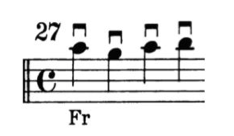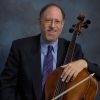
The Joy of Feuillard – A Sequential Approach to Teaching Bow Technique (Part 11 – Feuillard No. 32 – Variations #27-30)
Robert Jesselson
Part 11 – Feuillard No. 32 – Variations #27-30
Today’s blog will focus on circular motions, ballistics, and strokes at the frog that combine the upper arm and wrist.
Variation #27:

For this variation, I ask the students to use the full bow at a fairly fast tempo, rather than just playing at the frog as indicated. I am interested in seeing whether they can play with the bow remaining parallel to the bridge at a relatively fast bow speed, while using left/right motion. This is similar to the very first variation, although it is with all down-bows and a much faster bow speed. If the bow skits up or down the string, then the bow angle is not correct.
I also use this variation to introduce the vital concept of a “ballistic motion”. According to neurologist Dr. Frank Wilson, this is “very energetic and short lasting. It launches the limb in a set direction and ceases long before the limb will have completed its course of action. Because of the similarity of this kind of move to the firing of a gun shell, it was called ‘ballistic’. ”
We have two possibilities for bringing the bow back when you reach the tip. You can either pull the hand back, which uses muscles, or you can use the “boomerang” effect to let the arm bounce back. The latter saves energy and is a more efficient use of the body.
We also use ballistics in vibrato: instead of actively moving the arm up and down in the vibrato motion, we can save energy by initiating the motion upward, and then letting the arm bounce back in the opposite direction by relaxing. We will also use ballistics in the next several variations.
Variations #28-30:

These variations explore the interaction of the upper arm (active motion) and the wrist (passive motion) at the frog. Ballistics also plays a role in these strokes. One of the goals is to figure out how to release tension, so that we are not squeezing the thumb on the frog in a “death grip”. It is also important that the bow stroke always starts from the string, especially on the upbows in #29 and 30.
With today’s Blog we finish the page of Feuillard No. 32 and all the variations. I would like to thank Caroline for having agreed to be featured in these videos. She has made remarkable progress in her basic understanding of bow usage, and she has changed her perception of sound over the last few weeks. She will be continuing her bow work with the variations in No. 33 and beyond.
With next week’s Blog we will start on Feuillard No. 33 . My student Iestyn will be working on the theme and variations on that page as we explore further concepts about bow usage including son filé , flying spiccato, coordination, bow distribution, etc.
*If you have questions or comments about The Joy of Feuillard, Dr. Robert Jesselson can be reached directly at rjesselson@mozart.sc.edu.
Subjects: Repertoire, Technique
